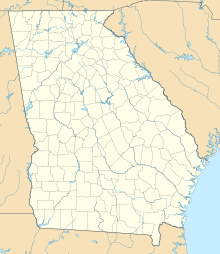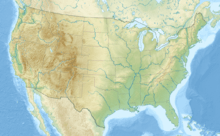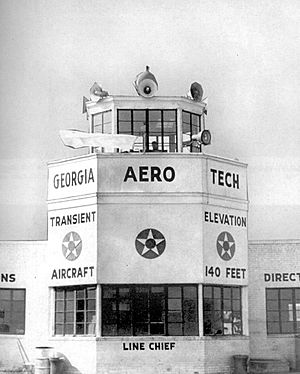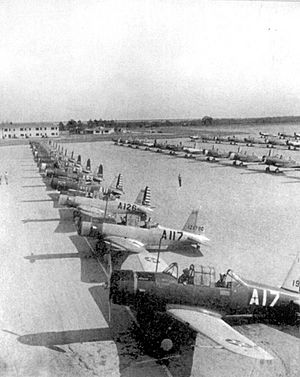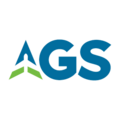Augusta Regional Airport facts for kids
Quick facts for kids
Augusta Regional Airport
at Bush Field |
|||||||||||||||
|---|---|---|---|---|---|---|---|---|---|---|---|---|---|---|---|
 |
|||||||||||||||
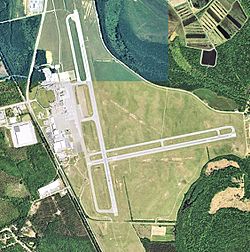
2006 USGS airphoto
|
|||||||||||||||
| Summary | |||||||||||||||
| Airport type | Public | ||||||||||||||
| Owner | City of Augusta | ||||||||||||||
| Serves | Augusta, Georgia | ||||||||||||||
| Elevation AMSL | 144 ft / 44 m | ||||||||||||||
| Coordinates | 33°22′12″N 81°57′52″W / 33.37000°N 81.96444°W | ||||||||||||||
| Map | |||||||||||||||
| Runway | |||||||||||||||
|
|||||||||||||||
| Statistics (2023) | |||||||||||||||
|
|||||||||||||||
|
Source: Airport Activity Report, Federal Aviation Administration
|
|||||||||||||||
Augusta Regional Airport (also known as Augusta Regional Airport at Bush Field) is a public airport. It is owned by the city of Augusta. You can find it about six miles (11 km) south of Augusta in Richmond County, Georgia.
In 2000, the airport, which was once called Bush Field, changed its name to Augusta Regional Airport. A brand new passenger terminal opened in December 2007. The whole airport got a makeover! Airlines like American Eagle, Delta Air Lines, and Delta Connection fly here. Their motto is "Fly There, Fly Home." Because of lower ticket prices, more and more people are choosing to fly from Augusta.
Contents
Airport Facts and Flights
Augusta Regional Airport is quite large, covering about 1,411 acres (571 hectares). It sits 144 feet (44 meters) above sea level. The airport has two main paths for planes to take off and land, called runways.
- One runway is 8,001 feet (2,439 meters) long and made of asphalt.
- The other is 6,002 feet (1,829 meters) long and also made of asphalt.
In one year (ending July 2022), there were over 42,000 aircraft operations at the airport. This means about 115 planes took off or landed each day! Most of these flights were for general aviation (private planes). Some were air taxis, military planes, or scheduled commercial flights. About 18 aircraft call this airport home. These include single-engine planes, multi-engine planes, jets, and helicopters.
Planes You Might See
In the past, many different types of planes flew from Augusta.
- In 2008, Delta Connection used smaller regional jets and turboprop planes.
- US Airways Express also used turboprops and regional jets.
- American Airlines took over US Airways Express in 2015. American Eagle then returned to Augusta.
Since May 2011, Delta Air Lines has been flying directly to Augusta again. They use Boeing 717-200 planes for flights to and from their main hub in Atlanta.
During the famous Masters golf tournament, the airport gets super busy! Airlines add more flights and use bigger planes. You might see Boeing 737s and Boeing 757s from Delta Air Lines. Even larger planes like Embraer E-170s and CRJ-900s are common.
Because Fort Eisenhower is nearby, military charter flights sometimes use the airport. These can be very large planes, like McDonnell Douglas DC-10s.
Airport History
How It Started
In 1941, the city of Augusta learned that the United States Army Air Corps needed a place to train pilots. A man named Harold S. Darr, who already ran a flight school, chose a large piece of land southeast of the city. It was next to the Savannah River. On March 22, 1941, Darr agreed to invest money to buy the land and build a school. The city and Richmond County helped by moving a hangar and paving a road to create a runway. The Army wanted training to start very quickly, by June 7, 1941. Construction began on April 1!
World War II Training
Pilot training started on June 10, 1941. Young pilots came from other flight schools. They learned to fly using Vultee BT-13 Valiant and BT-15 planes. The training course lasted ten weeks. It included 70 hours of flying and 150 hours of classroom learning. Harold Darr called his school Georgia Aero Tech. The Army named it the 72nd Army Air Force Flight Training Detachment.
Soon after training began, a flight instructor named Don C. Bush sadly died in a plane crash. The airfield was named Bush Field in his honor.
In 1942, the government bought the school. As the United States entered World War II, more pilots were needed. The school grew bigger, and more buildings were added. The number of planes increased from 24 to about 100! More paved runways were also built.
By 1943, the school was very busy, training around 160 students per class. But by 1944, fewer pilots were needed. In September 1944, the Air Force closed the facility. Over 5,000 students had been trained there. After the war, Bush Field was used to sell leftover military planes until 1948.
Becoming a Commercial Airport
Bush Field became Augusta's main commercial airport on July 1, 1950. The government gave Bush Field to the city of Augusta. All the airlines moved their operations from another local airport, Daniel Field, to Bush Field.
In 1955, the airport started selling fuel and providing services to visiting planes. This became a big source of income for the airport. Because of this, the airport has always been able to support itself. It has never needed money from taxpayers!
During the 1950s and 1960s, more and more people flew from Augusta. In 1961, a very long runway (8,000 feet or 2,438 meters) was finished. Jet planes started flying from the airport in 1965. By the end of the 1960s, the airport had grown a lot. It had a bigger baggage area, a new terminal building, a control tower, and more parking.
The 1970s brought industrial growth. A company called Capitol Aviation of Georgia (now Landmark Aviation) built a large airplane service facility. They repair jet engines and other plane parts. Today, Landmark Aviation employs about 220 people at the Augusta airport.
By the 1990s, the airport was a big part of the local economy. It created about 2,200 jobs. In 2000, Bush Field was officially renamed Augusta Regional Airport at Bush Field.
The airport created a "Master Plan" in 2002. This plan helps guide how the airport will grow and develop in the future.
Some of the old buildings from the World War II training school are still at Bush Field. The old dining hall and administration buildings were part of the airport's terminal. The original swimming pool was there until 2008. The new terminal building replaced many of these old structures. The Federal Aviation Administration (FAA) now uses the old Link trainer building. All the old hangars are still in use today, even the one moved from Daniel Field in 1941!
In 2021, Augusta Regional Airport became the base for Augusta University Health's AirCare program. This is an air ambulance service. It uses helicopters to transport patients to and from Augusta University Medical Center.
Airlines and Destinations
| Airlines | Destinations |
|---|---|
| American Eagle | Charlotte, Dallas/Fort Worth, Washington–National |
| Delta Connection | Atlanta |
| Destinations map |
|---|
Most Popular Destinations
Here are the busiest flight routes from Augusta Regional Airport. This information is from February 2023 to January 2024.
| Rank | City | Passengers |
|---|---|---|
| 1 | Atlanta, Georgia | 134,180 |
| 2 | Charlotte, North Carolina | 97,420 |
| 3 | Dallas/Fort Worth, Texas | 25,110 |
| 4 | Washington (Reagan), DC | 16,910 |
| 5 | New York (LaGuardia), New York | 1,260 |
| 6 | Philadelphia, Pennsylvania | 810 |
| 7 | Miami, Florida | 800 |
| 8 | Chicago (O'Hare), Illinois | 700 |
| 9 | Detroit, Michigan | 450 |
| 10 | Boston, Massachusetts | 390 |
Images for kids


